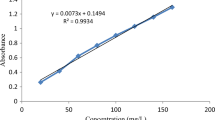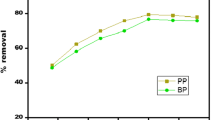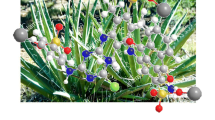Abstract
The adsorption behavior of basic, methylene blue (MB), and reactive, remazol brilliant violet 5R (RBV), dyes from aqueous solution onto Intsia bijuga sawdust-based activated carbon (IBSAC) was executed via batch and column studies. The produced activated carbon was characterized through Brunauer-Emmett-Teller (BET) surface area and pore structural analysis, proximate and ultimate, scanning electron microscopy (SEM), and Fourier transform infrared spectroscopy (FTIR). Batch studies were performed to investigate the effects of contact time, initial concentration, and solution pH. The equilibrium data for both MB and RBV adsorption better fits Langmuir model with maximum adsorption capacity of 434.78 and 212.77 mg/g, respectively. Kinetic studies for both MB and RBV dyes showed that the adsorption process followed a pseudo-second-order and intraparticle diffusion kinetic models. For column mode, the breakthrough curves were plotted by varying the flow rate, bed height, and initial concentration and the breakthrough data were best correlated with the Yoon-Nelson model compared to Thomas and Adams-Bohart model. The adsorption activity of IBSAC shows good stability even after four consecutive cycles.









Similar content being viewed by others
References
Aboua KN, Yobouet YA, Yao KB et al (2015) Investigation of dye adsorption onto activated carbon from the shells of Macoré fruit. J Environ Manag 156:10–14
Aeenjan F, Javanbakht V (2017) Methylene blue removal from aqueous solution by magnetic clinoptilolite/chitosan/EDTA nanocomposite. Res Chem Intermed 44:1459–1483
Ahmad MA, Ahmad Puad NA, Bello OS (2014) Kinetic, equilibrium and thermodynamic studies of synthetic dye removal using pomegranate peel activated carbon prepared by microwave-induced KOH activation. Water Resour Ind 6:18–35
Aljeboree AM, Alshirifi AN, Alkaim AF (2014) Kinetics and equilibrium study for the adsorption of textile dyes on coconut shell activated carbon. Arab J Chem 1:1–13
Altıntıg E, Altundag H, Tuzen M, Sarı A (2017) Effective removal of methylene blue from aqueous solutions using magnetic loaded activated carbon as novel adsorbent. Chem Eng Res Des 122:151–163
Baghdadi M, Alipour Soltani B, Nourani M (2017) Malachite green removal from aqueous solutions using fibrous cellulose sulfate prepared from medical cotton waste: comprehensive batch and column studies. J Ind Eng Chem 55:128–139
Bello OS, Ahmad MA (2011) Removal of Remazol brilliant violet-5R dye using periwinkle shells. Chem Ecol 27:481–492
Bhatti HN, Jabeen A, Iqbal M et al (2017) Adsorptive behavior of rice bran-based composites for malachite green dye: isotherm, kinetic and thermodynamic studies. J Mol Liq 237:322–333
Boopathy R, Karthikeyan S, Mandal AB, Sekaran G (2013) Adsorption of ammonium ion by coconut shell-activated carbon from aqueous solution: kinetic, isotherm, and thermodynamic studies. Environ Sci Pollut Res 20:533–542
Chen W, He F, Zhang S et al (2018) Development of porosity and surface chemistry of textile waste jute-based activated carbon by physical activation. Environ Sci Pollut Res 25:9840–9848
Cunha MR, Lima EC, Cimirro NFGM et al (2018) Conversion of Eragrostis plana Nees leaves to activated carbon by microwave-assisted pyrolysis for the removal of organic emerging contaminants from aqueous solutions. Environ Sci Pollut Res
Darweesh TM, Ahmed MJ (2017) Batch and fixed bed adsorption of levofloxacin on granular activated carbon from date (Phoenix dactylifera L.) stones by KOH chemical activation. Environ Toxicol Pharmacol 50:159–166
Dawood S, Sen TK (2014) Review on dye removal from its aqueous solution into alternative cost Ef- fective and non-conventional adsorbents. J Chem proc Engg J Chem. Process Eng 1:1–11
de Franco MAE, de Carvalho CB, Bonetto MM et al (2017) Removal of amoxicillin from water by adsorption onto activated carbon in batch process and fixed bed column: kinetics, isotherms, experimental design and breakthrough curves modelling. J Clean Prod 161:947–956
Fontana KB, Chaves ES, Sanchez JDS et al (2016) Textile dye removal from aqueous solutions by malt bagasse: isotherm, kinetic and thermodynamic studies. Ecotoxicol Environ Saf 124:329–336
Foo KY, Hameed BH (2012a) Mesoporous activated carbon from wood sawdust by K2CO3 activation using microwave heating. Bioresour Technol 111:425–432
Foo KY, Hameed BH (2012b) Adsorption characteristics of industrial solid waste derived activated carbon prepared by microwave heating for methylene blue. Fuel Process Technol 99:103–109
Gadigayya Mavinkattimath R, Shetty Kodialbail V, Govindan S (2017) Simultaneous adsorption of Remazol brilliant blue and disperse orange dyes on red mud and isotherms for the mixed dye system. Environ Sci Pollut Res 24:18912–18925
Garcia JR, Sedran U, Zaini MAA, Zakaria ZA (2017) Preparation, characterization, and dye removal study of activated carbon prepared from palm kernel shell. Environ Sci Pollut Res 25:5076–5085
Islam MA, Sabar S, Benhouria A et al (2017) Nanoporous activated carbon prepared from karanj (Pongamia pinnata) fruit hulls for methylene blue adsorption. J Taiwan Inst Chem Eng 74:96–104
Kalavathy H, Karthik B, Miranda LR (2010) Removal and recovery of Ni and Zn from aqueous solution using activated carbon from Hevea brasiliensis: batch and column studies. Colloids Surf B Biointerfaces 78:291–302
Karaçetin G, Sivrikaya S, Imamoʇlu M (2014) Adsorption of methylene blue from aqueous solutions by activated carbon prepared from hazelnut husk using zinc chloride. J Anal Appl Pyrolysis 110:270–276
Kazemi F, Younesi H, Ghoreyshi AA et al (2016) Thiol-incorporated activated carbon derived from fir wood sawdust as an efficient adsorbent for the removal of mercury ion: batch and fixed-bed column studies. Process Saf Environ Prot 100:22–35
Khan EA, Shahjahan, Khan TA (2018) Adsorption of methyl red on activated carbon derived from custard apple (Annona squamosa) fruit shell: equilibrium isotherm and kinetic studies. J Mol Liq 249:1195–1211
Khanday WA, Marrakchi F, Asif M, Hameed BH (2017) Mesoporous zeolite–activated carbon composite from oil palm ash as an effective adsorbent for methylene blue. J Taiwan Inst Chem Eng 70:32–41
Khasri A, Bello OS, Ahmad MA (2018) Mesoporous activated carbon from Pentace species sawdust via microwave-induced KOH activation : optimization and methylene blue adsorption. Res Chem Intermed
Kumar A, Jena HM (2016) Removal of methylene blue and phenol onto prepared activated carbon from fox nutshell by chemical activation in batch and fixed-bed column. J Clean Prod 137:1246–1259
Mahamad MN, Zaini MAA, Zakaria ZA (2015) Preparation and characterization of activated carbon from pineapple waste biomass for dye removal. Int Biodeterior Biodegrad 102:274–280
Mahmoudi K, Hosni K, Hamdi N, Srasra E (2014) Kinetics and equilibrium studies on removal of methylene blue and methyl orange by adsorption onto activated carbon prepared from date pits-a comparative study. Korean J Chem Eng 32:274–283
Miyah Y, Lahrichi A, Idrissi M et al (2018) Adsorption of methylene blue dye from aqueous solutions onto walnut shells powder: equilibrium and kinetic studies. Surf Interfaces 11:74–81
Mohammad M, Maitra S, Dutta BK (2018) Comparison of activated carbon and physic seed hull for the removal of malachite green dye from aqueous solution. Water Air Soil Pollut 229
Monteiro MS, de Farias RF, Chaves JAP et al (2017) Wood (Bagassa guianensis Aubl) and green coconut mesocarp (Cocos nucifera) residues as textile dye removers (Remazol red and Remazol brilliant violet). J Environ Manag 204:23–30
Nair V, Vinu R (2016) Peroxide-assisted microwave activation of pyrolysis char for adsorption of dyes from wastewater. Bioresour Technol 216:511–519
Nazari G, Abolghasemi H, Esmaieli M, Sadeghi Pouya E (2016) Aqueous phase adsorption of cephalexin by walnut shell-based activated carbon: a fixed-bed column study. Appl Surf Sci 375:144–153
Nugroho JD, Mansur I, Purwito A, Suhendang E (2010) Morphological characteristics of Ectomycorrhizas on merbau [Intsia bijuga (Colebr.) O. Kuntze]. HAYATI J Biosci 17:68–72
Pezoti O, Cazetta AL, Souza IPAF et al (2014) Adsorption studies of methylene blue onto ZnCl2-activated carbon produced from Buriti shells (Mauritia flexuosa L.). J Ind Eng Chem 20:4401–4407
Saleh TA, Gupta VK (2014) Processing methods, characteristics and adsorption behavior of tire derived carbons: a review. Adv Colloid Interf Sci 211:93–101
Salleh MAM, Mahmoud DK, Karim WAWA, Idris A (2011) Cationic and anionic dye adsorption by agricultural solid wastes: a comprehensive review. Desalination 280:1–13
Saygili H, Guzel F (2016) High surface area mesoporous activated carbon from tomato processing solid waste by zinc chloride activation: process optimization, characterization and dyes adsorption. J Clean Prod 113:995–1004
Shahul Hameed K, Muthirulan P, Meenakshi Sundaram M (2017) Adsorption of chromotrope dye onto activated carbons obtained from the seeds of various plants: equilibrium and kinetics studies. Arab J Chem 10:S2225–S2233
Shoukat S, Bhatti HN, Iqbal M, Noreen S (2017) Mango stone biocomposite preparation and application for crystal violet adsorption: a mechanistic study. Microporous Mesoporous Mater 239:180–189
Soto ML, Moure A, Domínguez H, Parajó JC (2017) Batch and fixed bed column studies on phenolic adsorption from wine vinasses by polymeric resins. J Food Eng 209:52–60
Spagnoli AA, Giannakoudakis DA, Bashkova S (2017) Adsorption of methylene blue on cashew nut shell based carbons activated with zinc chloride: the role of surface and structural parameters. J Mol Liq 229:465–471
Tahir N, Bhatti HN, Iqbal M, Noreen S (2017) Biopolymers composites with peanut hull waste biomass and application for crystal violet adsorption. Int J Biol Macromol 94:210–220
Vijayaraghavan K, Won SW, Yun YS (2009) Treatment of complex Remazol dye effluent using sawdust- and coal-based activated carbons. J Hazard Mater 167:790–796
Wong S, Yac’cob NAN, Ngadi N, et al (2017) From pollutant to solution of wastewater pollution: Synthesis of activated carbon from textile sludge for dye adsorption. Chinese J Chem Eng 1–9
Xu J, Chen L, Qu H et al (2014) Preparation and characterization of activated carbon from reedy grass leaves by chemical activation with H3PO4. Appl Surf Sci 320:674–680
Funding
This study was funded by the Universiti Sains Malaysia under the Iconic grant scheme (Grant No. 1001/CKT/870023) for research associated with the Solid Waste Management Cluster, Bridging grant (304.PJKIMIA.6316100) and short term grant (304.PJKIMIA.60312032).
Author information
Authors and Affiliations
Corresponding author
Additional information
Responsible editor: Tito Roberto Cadaval Jr
Rights and permissions
About this article
Cite this article
Khasri, A., Ahmad, M.A. Adsorption of basic and reactive dyes from aqueous solution onto Intsia bijuga sawdust-based activated carbon: batch and column study. Environ Sci Pollut Res 25, 31508–31519 (2018). https://doi.org/10.1007/s11356-018-3046-3
Received:
Accepted:
Published:
Issue Date:
DOI: https://doi.org/10.1007/s11356-018-3046-3




